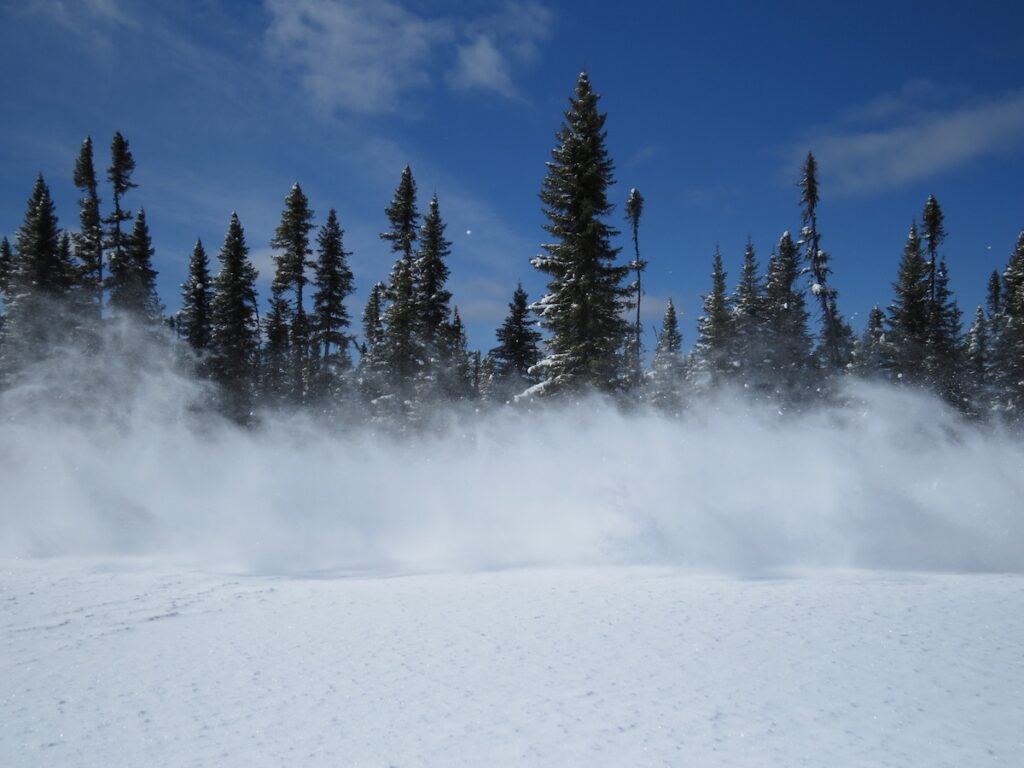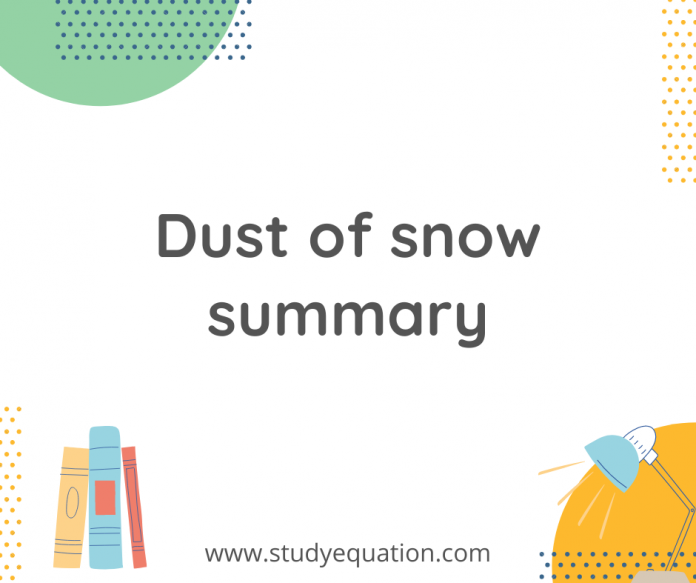Dust of snow summary with mcqs, questions and answers and pdf – This is a beautiful poem by the popular poet, Robert Frost. It is about how simple acts of nature can have a deeper meaning and has the power to change one’s mood and make one think in a positive manner.
The way a crow
Shook down on me
The dust of snow
From a hemlock treeHas given my heart
A change of mood
And saved some part
Of a day I had rued.
Table of Contents
Dust of snow summary
This poem says that there is a tremendous meaning to even a single moment. In this poem the poet describes the crow and the hemlock tree. Crow means his sad and sorrowful state, and a poisonous tree is the hemlock tree. All of these suggest that the poet was not in a happy mood, but to present his similar mood, he portrays the bleak, sad and bitter side of nature.
Also Read : The Hack Driver Summary
The poet explains he was in a miserable, gloomy mood once and sat under a hemlock tree. Sitting on the same tree, a crow shook snow dust off the author, i.e. tiny particles of snow that linger on the soil after the snowfall. The poet’s mood was changed by this simple action which made him realise that a lot of his day had only been spent repenting and getting lost in sorrow. But the shift in his attitude made him understand that he can use the rest of the fay for any beneficial endeavor.

Conclusion
Dust of snow summary with mcqs, questions and answers and pdf – throws light on the change of attitude of the poet when dust of snow fell on him and made him realise that he can use the rest of the day to be productive.
Poetic devices used
- Rhyme Scheme- abab cdcd.
- Alliteration- the occurrence of the same letter or sound at the beginning of adjacent or closely connected words. – Has given my heart; And saved some part.
- inversion – when the structure of a sentence is changed by the poet to create rhyme, this poetic license is called inversion. In stanza 1, inversion can be seen.
- assonance – the prominence of a vowel sound throughout a line is called assonance. In stanza 1, line 2 – “Shook down on me” – ‘o’ sound is prominent.
- enjambment – when the same sentence continues to the next line without the use of any punctuation marks, it is called enjambment. It has been used thorughout the poem.
Dust of Snow summary Question and Answers
Q1) What is a “dust of snow”? What does the poet say has changed his mood? How has the poet’s mood changed?
Answer:
“Dust of snow” refers to the tiny particles of snow. The particles are so small that poet referred to them as “dust”. The poet was in an awful mood when particles of snow had fallen on him. This changed the poet’s frame of mind instantly and his day got a lot better.
Both crow and the hemlock tree represent sorrow. Frost has used both the negative creatures (crow and the hemlock tree) as the carriers of positivism and strength that transformed his day for the better. By not using birds like sparrow and nightingale and trees like maple, oak or a pine, the poet has tried to break down all the preconceived notions we have about certain agents of nature.
He has tried to make us understand that we see the world not as how it is, but as how we want to see it. Thus, the crow sitting and a hemlock tree together made his day better. The dust of snow stands for joy.
Q2) How does Frost present nature in this poem? The following questions may help you to think of an answer.
(i) What are the birds that are usually named in poems? Do you think a crow is often mentioned in poems? What images come to your mind when you think of a crow?
A. Birds like sparrow, nightingale and peacock are more than often named in poems. Unlike these birds, crows are often seen as the indicators of doom and fear. They are often used for negative references.
(ii) Again, what is “a hemlock tree”? Why doesn’t the poet write about a more ‘beautiful’ tree such as a maple, or an oak, or a pine?
A. Trees are also seen as mighty creatures imparting wisdom as they’re too old. They give out oxygen and absorb the carbon dioxide which is connected with absorbing all the negative energy. But there are trees that are poisonous too, like a hemlock tree. The poet does not mention a more ‘beautiful’ tree such as maple, oak or pine because he wants to indicate a sad scene. Being poisonous, a hemlock tree is considered bad and so, he refers to it.
Dust of snow summary Extra questions
Q1) Simple moment proves to be very significant and saves rest of the day of poet from being wasted. Explain on the basis of the poem ‘Dust of Snow”.
Answer:
The poet says that once he was in a sad, depressive mood and was sitting under a hemlock tree. A crow, sitting on the same tree, shook off the dust of snow, small particles of snow that remained on the surface after the snowfall, on the poet. This simple action changed the poet’s mood.
He realised that he had just wasted a part of his day repenting and being lost in sorrow. But the change in his mood made him realise that he should utilize the rest of the day in some useful activity. His sorrow was washed away by the light shower of dust of snow. His spirit was revived and he got ready to utilize the rest of the day.
Q2) The poet was sad and depressed. But one comical incident lifts his spirits. He is full of joy and happiness again. Based on your reading of the poem, write a paragraph on the topic – Happiness is relative.
Answer:
No one is always happy. It is just a passing phase of one’s life which varies from time to time and place to place. It depends on certain people who you are close to. There are times when we are extremely happy or sorrowful. In most circumstances, our happiness is decided l>y certain moments in our life. Some light moments can really enliven our mood. The actions of our friends can make us happy or sometimes sorrowful. We must also realize that on every cloud there is a silver lining. This means that every sorrowful moment is followed by a period of joy and happiness.
Extra questions
Q3) What do the ‘Hemlock’ tree and ‘Crow’ represent? What does the dust of snow metaphorically stand for ?
Answer:
The poet was going somewhere in a snowy morning. He was upset. All the trees were covered with snow dust. A crow sitting on a hemlock tree shook the tree in such a way that some dust of snow fell on the poet. This changed his mood and he became happy and relaxed.
Q4) How did the crow change the poet’s mood?
Answer:
The poet was going somewhere in a snowy morning. He was upset. All the trees were covered with snow dust. A crow sitting on a hemlock tree shook the tree in such a way that some dust of snow fell on the poet. This changed his mood and he became happy and relaxed.
Q5) What was the reaction of the poet when the dust of snow fell on him?
Answer:
Normally, people thought both crow and hemlock tree are auspicious. But when the dust of snow from hemlock tree fell on poet, he took it in other way. He was depressed and sorrowful but the moment the crow shook the hemlock tree and dust of snow fell on him, he felt unburdened and relieved.
Q6) How does the poet react to crow and hemlock tree?
Answer:
Crow and hemlock tree are considered inauspicious in the west. They are generally taken /is bad omen. But the poet did not take them in negative way. They saved his day. His negative outlook changed to the positive one.






… [Trackback]
[…] Read More here: studyequation.com/dust-of-snow-summary/ […]
… [Trackback]
[…] Here you can find 46864 more Info on that Topic: studyequation.com/dust-of-snow-summary/ […]
… [Trackback]
[…] Read More Info here to that Topic: studyequation.com/dust-of-snow-summary/ […]
… [Trackback]
[…] Find More Information here to that Topic: studyequation.com/dust-of-snow-summary/ […]